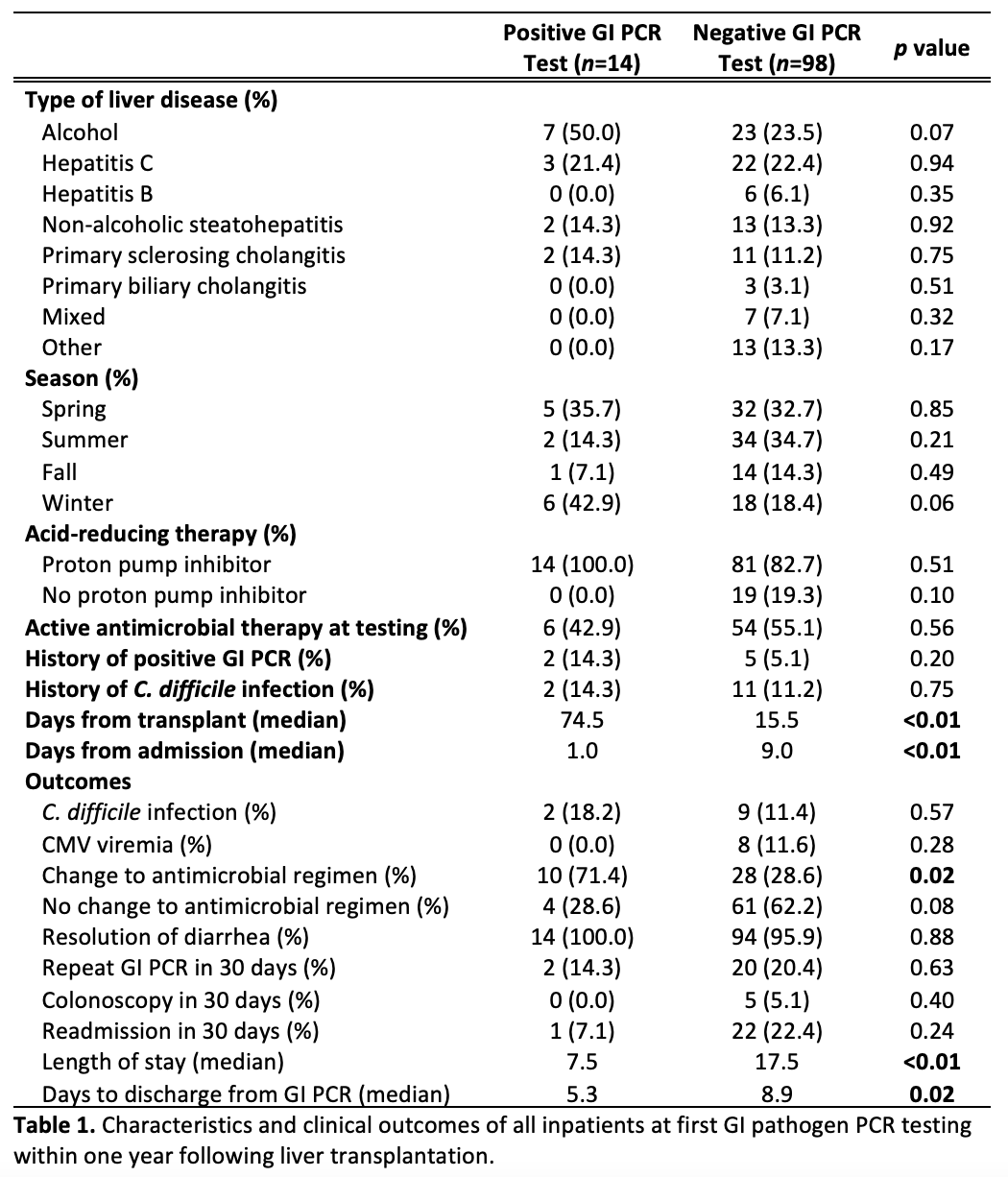The Role of Gastrointestinal Pathogen PCR Testing in Liver Transplant Recipients Hospitalized with Diarrheal Illness
C. K. Ching1, Y. R. Nobel2, M. R. Pereira3, E. C. Verna4
1Department of Medicine, Columbia University Medical Center, New York, NY, 2Division of Digestive and Liver Diseases, Columbia University Medical Center, New York, NY, 3Division of Infectious Diseases, Columbia University Medical Center, New York, NY, 4Center for Liver Disease and Transplantation, Columbia University Medical Center, New York, NY
Meeting: 2022 American Transplant Congress
Abstract number: 1631
Keywords: Infection, Liver transplantation, Outcome, Polymerase chain reaction (PCR)
Topic: Clinical Science » Infection Disease » 24 - All Infections (Excluding Kidney & Viral Hepatitis)
Session Information
Session Name: All Infections (Excluding Kidney & Viral Hepatitis) IV
Session Type: Poster Abstract
Date: Tuesday, June 7, 2022
Session Time: 7:00pm-8:00pm
 Presentation Time: 7:00pm-8:00pm
Presentation Time: 7:00pm-8:00pm
Location: Hynes Halls C & D
*Purpose: Diarrhea is a common complication among liver transplant (LT) recipients and can result in significant morbidity. The development of PCR-based multiplex gastrointestinal (GI) pathogen panels has aided in the diagnosis and management of infectious causes of diarrhea. However, its utility in the LT population is unclear. In this study, we investigated the clinical applications of GI PCR testing in hospitalized LT recipients.
*Methods: We performed a retrospective cohort study of all inpatients who underwent stool pathogen testing with the FilmArray multiplex GI PCR panel at our institution within one year following LT from April 2015 to December 2019. Stool C. difficile and serum CMV PCR testing were also collected. Predictors of positive GI PCRs were identified, and changes in care and clinical outcomes were compared in individuals with or without a positive PCR.
*Results: Of the 112 inpatients who underwent GI PCR testing within one year following LT, 14 (12.5%) had a positive PCR for any pathogen: 52.9% were bacterial, 35.3% were viral, and 11.8% were parasitic. Escherichia coli and Norovirus GI/GII were the most common pathogens identified. Patients with a positive GI PCR were further from LT (median 74.5 vs 15.5 days; p<0.01) and tested earlier in admission (median 1.0 vs 9.0 days; p<0.01) compared to those with a negative GI PCR (Table 1). Following a positive GI PCR test, patients were more likely to have a change in antimicrobial regimen (71.4% vs 28.6%; p=0.02), a shorter length of hospital stay (median 7.5 vs 17.5 days; p<0.01), and fewer days to discharge from testing (median 5.3 vs 8.9 days; p=0.02). All patients with a positive GI PCR had resolution of diarrhea upon discharge.
*Conclusions: GI PCR testing in hospitalized LT recipients is a valuable tool to evaluate the etiology of diarrhea, altering care and decreasing length of stay when a pathogen is identified. GI PCR testing is most likely to be positive when tested in patients more than 75 days post-LT or within 1 day of admission, highlighting limited utility among patients with prolonged hospitalizations and multifactorial diarrhea. Larger studies are needed to fully characterize the predictors of GI PCR positivity and associated outcomes following LT.
To cite this abstract in AMA style:
Ching CK, Nobel YR, Pereira MR, Verna EC. The Role of Gastrointestinal Pathogen PCR Testing in Liver Transplant Recipients Hospitalized with Diarrheal Illness [abstract]. Am J Transplant. 2022; 22 (suppl 3). https://atcmeetingabstracts.com/abstract/the-role-of-gastrointestinal-pathogen-pcr-testing-in-liver-transplant-recipients-hospitalized-with-diarrheal-illness/. Accessed December 28, 2025.« Back to 2022 American Transplant Congress

